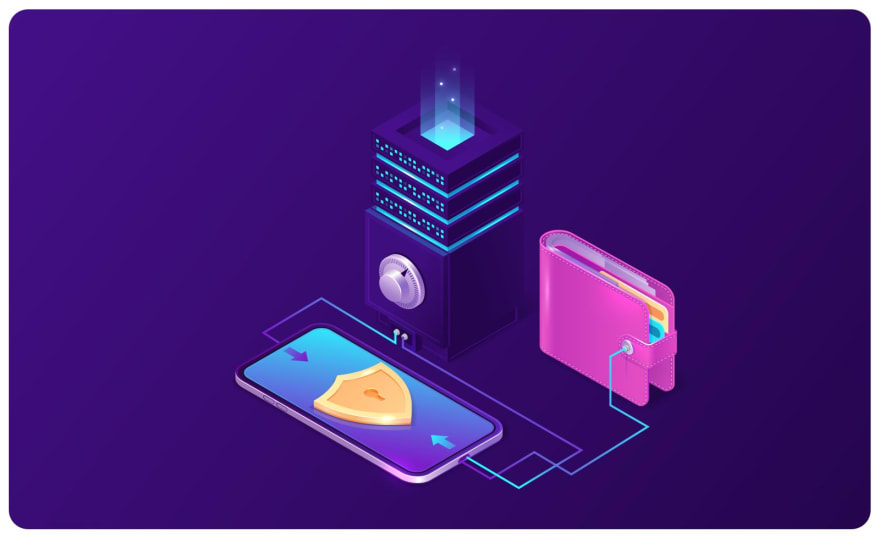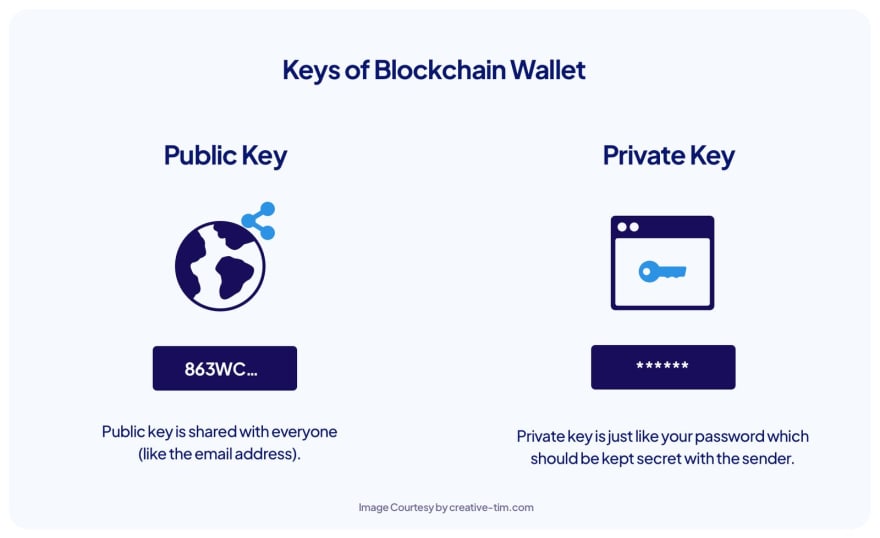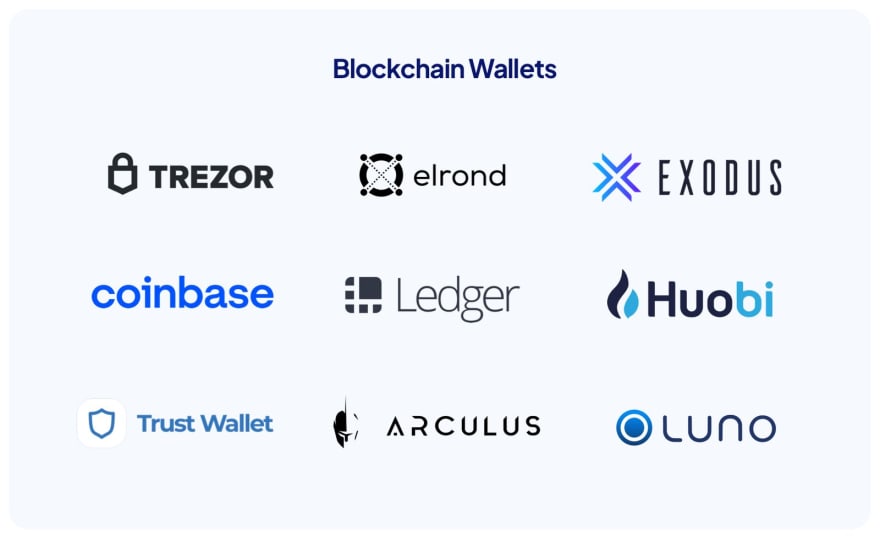A blockchain wallet, as the name suggests, is typically a wallet for blockchains.
Cryptocurrency/crypto is a form of digital currency which is not controlled by a central authority, uses a decentralized system to record transactions, and has its transactions secured using cryptography. A blockchain wallet (you've probably heard about the "bitcoin wallet") is a digital wallet that stores and allows the management of this cryptocurrency.
What exactly is a Blockchain Wallet?
Transitional banking systems and transactions depend on third parties or intermediaries to transfer information. This creates a central point of failure, thus potentially making accounts exposed to manipulation, corruption, or jeopardy. A blockchain wallet solves this issue by allowing the secure transfer of cryptocurrency funds.
Blockchain wallet apps can be downloaded, have their own login, work on websites, and hold your cryptocurrencies in a centralized location for easy access and management. By allowing transactions to be cryptographically signed in a secure manner, blockchain wallets provide all the features required for the easy transfer of crypto funds between parties.
How do Blockchain Wallets Work?
The understanding behind blockchain wallets requires an understanding of the difference between public and private keys. When a blockchain wallet is created, a public key, as well as a private key, is associated with the wallet.
- The cryptocurrency wallet public key is analogous to your email address. A hash function is used to encrypt the wallet's public key, and this hashed form of this public key is called your wallet address. You can send your wallet address to anyone, and they will be able to transfer funds to your account as and when required.
- The private key, however, is analogous to your email account password. The private key is top secret and allows you to access your cryptocurrencies, or transfer them to others.
- In reality, a blockchain wallet does not hold your cryptocurrency. Cryptocurrency resides on the blockchain over which it is built. A blockchain wallet simply secures and stores the digital key that allows access to your cryptocurrencies.
- When you need to send cryptocurrencies to another account:
- You use your private key to gain access to your wallet.
- You will be able to see the digital keys of the cryptocurrencies that you hold.
- You can specify the wallet address of the account where you want to send your funds.
- Once the funds go over, the recipient will be able to see them by accessing their wallet using their private key.
- Each transaction carried out by your private key generates a unique digital signature and the digital signature is stored in the wallet ledger. Even if your same private key is used to carry out different transactions, the digital signature is always different, and cannot be replicated or erased. This is based on the blockchain transaction technology, whereby all transactions are immutable.
See here how you can create strong Crypto passwords.
What are the types of Blockchain Wallets?
There are different subdivisions that divide blockchain wallets into different types.
Hot Wallets vs. Cold Wallets
Hot Wallets allow quick transfer of cryptocurrencies. They are available online, and are usually maintained on the cloud. The private keys of the wallets are stored in the cloud for faster access, and they can be accessed via desktop apps, mobile apps, or the web. Because of this exposure, they have a risk of being exposed or hacked. Examples are Coinbase Wallet, Blockchain.info, etc.
Cold Wallets are digital offline wallets that carry out offline transactions but disclose the transactions online. They are maintained offline, have high security, and store private keys in separate hardware that is not connected to any network. This method of transaction helps protect the wallet from unauthorized access, but cold wallet transfers are very slow. Trezor and Ledger are some examples.
Hardware vs. Software Wallets
Hardware Wallets are USB-like devices that are used to store and manage private keys, public addresses, and transactions. Most hardware wallets are fitted with OLED screens to track activities, have buttons to sign transactions and scroll, and offer native desktop apps for different cryptocurrencies. Hardware wallets are cheap and safe options since everything is offline. They are suitable for large organizations which focus on the security of transactions.
Software Wallets are applications downloaded on a device that allows access and management of cryptocurrencies. Software wallets are typically hot wallets but can also be cold wallets.
Desktop vs Online vs Mobile vs Web-based Wallets
All four wallets are the further sub-categories of software wallets.
Desktop Wallets, as the name suggests, are software wallets that are downloaded into a desktop. Desktop wallets are typically cold wallets as they can be unplugged from the internet and can carry out offline transactions which are later uploaded online. If the information in the main server is lost, the desktop is typically used as a backup server. While these wallets can be downloaded anywhere, they are only accessible from the system that they are installed on. Electrum is an example of a desktop wallet.
Online Wallets are the ones that are always online. These software wallets are hot wallets, can be downloaded as an app, and are accessible from any device at any given time. The private keys are stored online, managed by a third party, and available on a range of different devices and operating systems. The Bitcoin wallet is an example of an online wallet.
Mobile Wallets are similar to online wallets but are only built for use with mobile phones. With their user-friendly interface and fast access, mobile wallets have become increasingly popular. Mycelium is an example of a well-known mobile wallet.
Web-based Wallets are a type of software wallet that is hosted by exchange and is available on the web. Web-based wallets are also one type of online wallet but do not require downloading an application. Coinbase Global is an example of a web-based wallet.
Single currency vs Multi-currency wallets
Single Currency Wallets (like MyEther) store a single cryptocurrency, while multi-currency wallets (like Exodus, Ledger, Trezor) store the digital signature of a wide range of cryptocurrencies. Multi-currency wallets are easier as they allow people to deal with different cryptocurrencies, without the need for installing multiple wallets for each.
Deterministic vs Non-deterministic Wallets
Yet another classification of cryptocurrency wallets is based on the generation of private keys.
Deterministic Wallets are those whose private keys are related to each other back to a recovery seed. It means that if a private key is lost, it can be backed up using a seed. These wallets apply a single hash function to the seed and can recover lost private keys. This wallet is useful in an organizational setting with different departments and branches.
Non-deterministic Wallets are the ones whose private keys are not related to each other. While the wallet can generate more than one private key, the keys are not related to each other, and losing the key means that it cannot be recovered. This does pose an issue with management but is a secure option.
Why use a Blockchain Wallet?
Cryptocurrencies are slowly becoming the next era of financial currency exchanges. It is hence imperative that any cryptocurrency owned by a person or organization is stored. Just like a physical wallet holds your physical currency in one location and allows easy management of the currency, a blockchain wallet is a need in today’s day and time to manage all cryptos from a consolidated location.
Blockchain wallet reviews have brought up these benefits of using a blockchain wallet:
Borderless Transactions: While physical currency transfer is difficult to do across borders without intermediaries, rules, and regulations in between, blockchain wallets allow for borderless transactions minus the conversion and foreign exchange costs. This, in turn, reduces costs and reduces the need to share personal data with third parties.
Low transaction costs: A lot of money is used up when using intermediaries to transact huge amounts of money. This need is reduced when transactions happen with cryptocurrencies between cryptocurrency wallets.
Quicker transactions: Cryptocurrency transactions are quicker in comparison to legacy financial transactions which involve a lot of processes and intermediaries.
Simple Signups: Signing up for a cryptocurrency wallet is a fairly simple process that requires minimal documentation. On the other hand, creating a bank account or creating an account to access a bank vault is a fairly long process. This reduces the barriers of entry when it comes to cryptocurrency transactions.
High security: Is blockchain wallet safe? With no centralized authority controlling transactions, this might be a question on the mind of novice blockchain users. The underlying technology used by blockchain wallets makes them inherently secure. If you secure your private key, all of your transactions, your crypto, and your identity is safe and secure from the prying eyes of a hacker who can potentially hack banking systems with ease.
Multi-currency transfer: Blockchain wallets are an easy way to transfer multi-financial currencies as any currency can be converted to a cryptocurrency, and the cryptocurrency can be converted back to an y currency by sending it across geographical boundaries.
Easy to create and manage: Creating and managing a cryptocurrency wallet is a fairly simple process in comparison to creating and maintaining a bank as the legalities, costs, and time required is substantially lower.
Blockchain Wallet Fees
There are numerous benefits of using a blockchain wallet. However, blockchain transactions are not free.
Blockchain wallet fees are the fees incurred when carrying out blockchain transactions in or between wallets. Since these wallets allow conversion of local currency to cryptocurrency, transfer of cryptocurrency between user accounts, and the conversion of a cryptocurrency back to a local currency, they charge some fees. The blockchain wallet fees are mostly dynamic, which means that the transaction fees differ based on transaction size and type of transaction.
Typically, blockchain wallets have the following fees:
- Exchange fees: Typically 0 to 1.5% per trade depending on if you are a buyer or seller.
- Network fees: Typically depends on the platform.
For example, the processing fee for buying Elrond in the Elrond Wallet using a card or bank transfer is 2.90% to 4.50%. When buying 40 EGLD, the processing fee is approximately USD 46.61, and the network fee is approximately USD 0.05.
Best Blockchain Wallets
Blockchain wallet reviews carried out by newbies as well as experts in the field of cryptocurrency have boiled down to the following crypto wallets to be the best this year:
Elrond: A simple and secure crypto wallet which transfers and stores Elrond tokens to interact with Elrond dApps.
Exodus: The best blockchain wallet for desktop users
Trezor: A cold wallet that works best for people who value security
Coinbase Wallet: A hot wallet with advanced charting facilities
Ledger: Another cold wallet that also offers Bluetooth facilities
Huobi Pro: The most comprehensive hot wallet
Trust Wallet: A hot wallet that offers simple and intuitive design, best for beginners
Luno Wallet: The best wallet for newbies in the field of cryptocurrency exchanges
Arculus: A cold wallet that uses a secure hardware card
How to create a Blockchain Wallet?
With a huge number of people entering the cryptocurrency market, and the trend set to continue for years to come, you might be wondering how to create a blockchain wallet. Once you know how a cryptocurrency wallet works internally, you can follow the steps below to create your own:
1 - Understanding the basics
Before starting the development of a blockchain wallet, it makes sense to properly understand the basics of blockchain and what cryptocurrency is. There are a huge number of guides (like this one) that you can take reference from, to understand the same.
2 - Using open source libraries
Most cryptocurrencies are open source, and you can use the ones like BitcoinJ SDK or Coinbase SDK to build a wallet for iOS and Android platforms,
3 - Using APIs
You can use distributed ledger APIs to create a blockchain wallet that is feature rich. Using APIs like Bitcore, Factom, and Coinbase shortens development time and helps you delegate complex tasks out of your coding workflow.
4 - Using the cloud
If you choose to create a web-based wallet, you can use PaaS (Platform-as-a-service) systems. However, for app development, you can make use of BaaS (Blockchain-as-a-service) systems that are now being provided by Microsoft, Amazon, and Azure.
5 - Using the right technology
Decide on the technology stack that you wish to use, depending on the kind of wallet that you wish to create.
6 - Focus on security
A cryptocurrency wallet must be secure. Ensure that you include multi-factor authentication, enable continuous security updates, and be quick to identify and fix bugs.
7 - Check others and start building
Check the available and popular blockchain wallets to get an idea of what is lacking and what works, and start building your blockchain wallet.
Conclusion
This article covers the basics of blockchain wallets, the differences between different types of wallets, and how you can start creating your own blockchain wallet. With crypto certain to be the future of information technology, make sure that you are updated with all aspects related to it by checking out our other articles ⬇️
Are you interested in learning more about Web 3.0? Check out the following resources:
- Web 1.0 vs Web 2.0 vs Web 3.0. What are the differences?
- 25 Essential Web 3.0 Terms You Need to Know to Understand It
- What is Blockchain Technology and How Does it Work?
- What is Web 3.0? Everything explained
- Top 10+ Blockchain Networks to look for in 2023
- Web 3.0 & the Metaverse: The Future of the Internet











Top comments (0)